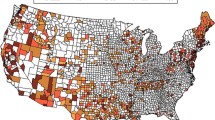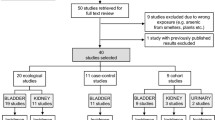Abstract
Arsenic is a bladder carcinogen though less is known regarding the specific temporal relationship between exposure and bladder cancer diagnosis. In this study, we modeled time-varying mixtures of arsenic exposures at many historic temporal windows to evaluate their association with bladder cancer risk in the New England Bladder Cancer Study. We used arsenic exposure estimates up to 60 years prior to study entry and compared the goodness of fit of models using these mixtures to those using summary measures of arsenic exposures. We used the Bayesian index low rank kriging multiple membership model (LRK-MMM) to estimate the associations of these mixtures with bladder cancer and estimate cumulative spatial risk for bladder cancer using participants’ residential histories. We found consistent evidence that modeling arsenic exposures as a time-varying mixture provided better fit to the data than using a single arsenic exposure summary measure. We estimated several positive though not significant associations of the time-varying arsenic mixtures with bladder cancer having odds ratios (ORs) of 1.03–1.14 and identified many significant and positive associations for an interaction among those who consumed water from a private dug well (ORs 1.28–1.60). Arsenic exposures 40–50 years before study entry received elevated importance weights in these mixtures. Additionally, we found two small areas of elevated cumulative spatial risk for bladder cancer in southern New Hampshire and in south central Maine. These results emphasize the importance of considering time-varying mixtures of exposures for diseases with long latencies such as bladder cancer.





Similar content being viewed by others
Data Availability
The data that support the findings of this study are available on request from the author Dr. Debra Silverman. The data are not publicly available due to privacy or ethical restrictions.
References
Cumberbatch MGK, Jubber I, Black PC et al (2018) Epidemiology of bladder cancer: a systematic review and contemporary update of risk factors in 2018. Eur Urol 74(6):784–795
Siegel RL, Miller KD, Wagle NS, Jemal A. Cancer statistics, 2023. CA: a cancer journal for clinicians. 2023;73(1):17–48.
Freedman ND, Silverman DT, Hollenbeck AR, Schatzkin A, Abnet CC (2011) Association between smoking and risk of bladder cancer among men and women. JAMA 306(7):737–745
Thun M, Linet MS, Cerhan JR, Haiman CA, Schottenfeld D (eds) (2017) Cancer epidemiology and prevention. Oxford University Press
IARC (2023) Agents classified by the IARC monographs, vol 1–133. International agency for research on cancer, May 5. https://monographs.iarc.who.int/agents-classified-by-the-iarc/. Accessed 5 July 2023
Marshall G, Ferreccio C, Yuan Y et al (2007) Fifty-year study of lung and bladder cancer mortality in Chile related to arsenic in drinking water. J Natl Cancer Inst 99(12):920–928
National Cancer Institute. Cancer Mortality Maps. http://ratecalc.cancer.gov
Baris D, Waddell R, Beane Freeman LE et al (2016) Elevated bladder cancer in Northern New England: the role of drinking water and arsenic. J Natl Cancer Inst. https://doi.org/10.1093/jnci/djw099
Wild CP (2005) Complementing the genome with an “exposome”: the outstanding challenge of environmental exposure measurement in molecular epidemiology. Cancer Epidemiol Prev Biomarkers 14(8):1847–1850
Wild CP (2012) The exposome: from concept to utility. Int J Epidemiol 41(1):24–32
Carrico C, Gennings C, Wheeler DC, Factor-Litvak P (2015) Characterization of weighted quantile sum regression for highly correlated data in a risk analysis setting. J Agric Biol Environ Stat 20(1):100–120. https://doi.org/10.1007/s13253-014-0180-3
Czarnota J, Gennings C, Wheeler DC (2015) Assessment of weighted quantile sum regression for modeling chemical mixtures and cancer risk. Cancer Inf 14:CIN.S17295
Liu SH (2016) Statistical methods for estimating the effects of multi-pollutant exposures in children’s health research. Doctoral dissertation, Harvard University, Graduate School of Arts & Sciences
Liu SH, Bobb JF, Lee KH et al (2018) Lagged kernel machine regression for identifying time windows of susceptibility to exposures of complex mixtures. Biostatistics 19(3):325–341
Keil AP, Buckley JP, O’Brien KM, Ferguson KK, Zhao S, White AJ (2020) A quantile-based g-computation approach to addressing the effects of exposure mixtures. Environ Health Perspect 128(4):47004
Wei P, Tang H, Li D (2014) Functional logistic regression approach to detecting gene by longitudinal environmental exposure interaction in a case-control study. Genet Epidemiol 38(7):638–651
Wheeler DC, Rustom S, Carli M, Whitehead TP, Ward MH, Metayer C (2021) Bayesian group index regression for modeling chemical mixtures and cancer risk. Int J Environ Res Public Health 18(7):3486
Levin-Schwartz Y, Gennings C, Schnaas L et al (2019) Time-varying associations between prenatal metal mixtures and rapid visual processing in children. Environ Health 18(1):1–12
Boyle J, Ward MH, Cerhan JR, Rothman N, Wheeler DC (2023) Modeling historic neighborhood deprivation and non-Hodgkin lymphoma risk. Environm Res (under review). Published online.
Wang Q, Benmarhnia T, Zhang H et al (2018) Identifying windows of susceptibility for maternal exposure to ambient air pollution and preterm birth. Environ Int 121:317–324
Darrow LA, Klein M, Strickland MJ, Mulholland JA, Tolbert PE (2011) Ambient air pollution and birth weight in full-term infants in Atlanta, 1994–2004. Environ Health Perspect 119(5):731–737. https://doi.org/10.1289/ehp.1002785
Petrof O, Neyens T, Nuyts V, Nackaerts K, Nemery B, Faes C (2020) On the impact of residential history in the spatial analysis of diseases with a long latency period: a study of mesothelioma in Belgium. Stat Med 39(26):3840–3866
Boyle J, Ward MH, Koutros S et al (2022) Estimating cumulative spatial risk over time with low-rank kriging multiple membership models. Stat Med 41(23):4593–4606
Boyle J, Ward MH, Cerhan JR, Rothman N, Wheeler DC (2022) Estimating mixture effects and cumulative spatial risk over time simultaneously using a Bayesian index low-rank kriging multiple membership model. Stat Med 41(29):5679–5697
Boyle J, Ward MH, Cerhan JR, Rothman N, Wheeler DC (2023) Modeling historic environmental pollutant exposures and non-Hodgkin lymphoma risk. Environ Res 224:115506
Baris D, Karagas MR, Verrill C et al (2009) A case–control study of smoking and bladder cancer risk: emergent patterns over time. J Natl Cancer Inst 101(22):1553–1561
Miyakawa M, Tachibana M, Miyakawa A et al (2001) Re-evaluation of the latent period of bladder cancer in dyestuff-plant workers in Japan. Int J Urol 8(8):423–430
Colt JS, Karagas MR, Schwenn M et al (2011) Occupation and bladder cancer in a population-based case–control study in Northern New England. Occup Environ Med 68(4):239–249
Nuckols JR, Freeman LEB, Lubin JH et al (2011) Estimating water supply arsenic levels in the New England Bladder Cancer Study. Environ Health Perspect 119(9):1279–1285
Shaddick G, Zidek JV (2014) A case study in preferential sampling: Long term monitoring of air pollution in the UK. Spatial Statistics 9:51–65
Diggle PJ, Tawn JA, Moyeed RA (1998) Model-based geostatistics. J Roy Stat Soc: Ser C (Appl Stat) 47(3):299–350
Teitz MB, Bart P (1968) Heuristic methods for estimating the generalized vertex median of a weighted graph. Oper Res 16(5):955–961
Boyle J, Wheeler DC (2022) Knot selection for low-rank kriging models of spatial risk in case-control studies. Spatial Spatio-Temporal Epidemiol 41:100483
Plummer M et al. (2003) JAGS: a program for analysis of Bayesian graphical models using Gibbs sampling. In: Proceedings of the 3rd international workshop on distributed statistical computing, vol 124. Vienna, Austria, pp. 1–10.
R Core Team et al. (2021). R: a language and environment for statistical computing. Published online.
Gelman A, Rubin DB (1992) Inference from iterative simulation using multiple sequences. Stat Sci 7(4):457–472
Plummer M, Best N, Cowles K, Vines K (2006) CODA: convergence diagnosis and output analysis for MCMC. R News 6(1):7–11
Spiegelhalter DJ, Best NG, Carlin BP, Van Der Linde A (2002) Bayesian measures of model complexity and fit. J R Stat Soc: Ser B (Stat Methodol) 64(4):583–639
MRC (2022) DIC: deviance information criteria. University of Cambridge Biostatistics Unit. https://www.mrc-bsu.cam.ac.uk/software/bugs/the-bugs-project-dic/
Richardson S, Thomson A, Best N, Elliott P (2004) Interpreting posterior relative risk estimates in disease-mapping studies. Environ Health Perspect 112(9):1016–1025
Smith AH, Marshall G, Roh T, Ferreccio C, Liaw J, Steinmaus C (2018) Lung, bladder, and kidney cancer mortality 40 years after arsenic exposure reduction. J Natl Cancer Inst 110(3):241–249. https://doi.org/10.1093/jnci/djx201
de Vuijst E, van Ham M, Kleinhans R (2016) A life course approach to understanding neighbourhood effects. IZA Discussion paper #10276:10276.
Halfon N, Hochstein M (2002) Life course health development: an integrated framework for developing health, policy, and research. Milbank Quar 80(3):433–479
Cantor KP, Lubin JH (2007) Arsenic, internal cancers, and issues in inference from studies of low-level exposures in human populations. Toxicol Appl Pharmacol 222(3):252–257
D’Angelo D, Norton SA, Loiselle MC (1996) Historical uses and fate of arsenic in Maine. Water Research Institute, Sawyer Environmental Research Center, University
Barry KH, Jones RR, Cantor KP et al (2020) Ingested nitrate and nitrite and bladder cancer in Northern New England. Epidemiology 31(1):136–144. https://doi.org/10.1097/EDE.0000000000001112
Funding
Research reported in this publication was supported by the National Cancer Institute of the National Institutes of Health under Award No. U01CA259376. The content is solely the responsibility of the authors and does not necessarily represent the official views of the National Institutes of Health.
Author information
Authors and Affiliations
Corresponding author
Supplementary Information
Below is the link to the electronic supplementary material.
Rights and permissions
About this article
Cite this article
Boyle, J., Ward, M.H., Koutros, S. et al. Modeling Historic Arsenic Exposures and Spatial Risk for Bladder Cancer. Stat Biosci (2023). https://doi.org/10.1007/s12561-023-09404-7
Received:
Revised:
Accepted:
Published:
DOI: https://doi.org/10.1007/s12561-023-09404-7




